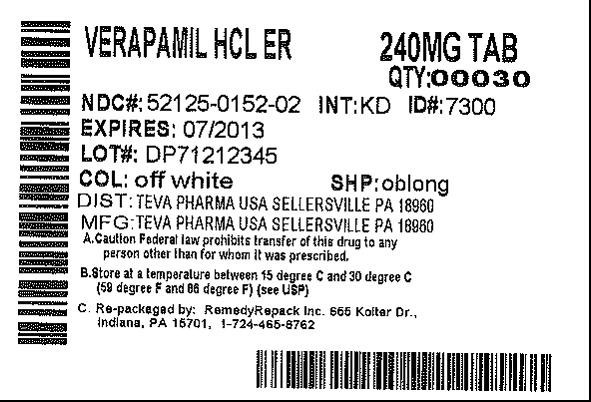Verapamil Hydrochloride
FULL PRESCRIBING INFORMATION: CONTENTS*
- VERAPAMIL HYDROCHLORIDE DESCRIPTION
- CLINICAL PHARMACOLOGY
- INDICATIONS & USAGE
- VERAPAMIL HYDROCHLORIDE CONTRAINDICATIONS
- WARNINGS
- PRECAUTIONS
- VERAPAMIL HYDROCHLORIDE ADVERSE REACTIONS
- OVERDOSAGE
- DOSAGE & ADMINISTRATION
- HOW SUPPLIED
- STORAGE AND HANDLING
- PACKAGE LABEL.PRINCIPAL DISPLAY PANEL SECTION
FULL PRESCRIBING INFORMATION
VERAPAMIL HYDROCHLORIDE DESCRIPTION

CLINICAL PHARMACOLOGY
Mechanism of Action
WARNINGS).
WARNINGS).
Pharmacokinetics and Metabolism
PRECAUTIONS);the volume of distribution is increased and plasma clearance reduced to about 30% of normal. Verapamil clearance values suggest that patients with liver dysfunction may attain therapeutic verapamil plasma concentrations with one-third of the oral daily dose required for patients with normal liver function.
PRECAUTIONS, Drug Interactions).
Hemodynamics and Myocardial Metabolism
Drug Interactions).
Pulmonary Function
INDICATIONS & USAGE
VERAPAMIL HYDROCHLORIDE CONTRAINDICATIONS
WARNINGS).
WARNINGS).
WARNINGS
Heart FailureDrug Interactions).Patients with milder ventricular dysfunction should, if possible, be controlled with optimum doses of digitalis and/or diuretics before verapamil treatment.(Note interactions with digoxin under PRECAUTIONS).
Hypotension
Elevated Liver Enzymes
Elevations of transaminases with and without concomitant elevations in alkaline phosphatase and bilirubin have been reported. Such elevations have sometimes been transient and may disappear even in the face of continued verapamil treatment. Several cases of hepatocellular injury related to verapamil have been proven by rechallenge; half of these had clinical symptoms (malaise, fever, and/or right upper quadrant pain) in addition to elevations of SGOT, SGPT, and alkaline phosphatase. Periodic monitoring of liver function in patients receiving verapamil is therefore prudent.
Accessory Bypass Tract (Wolff-Parkinson-White or Lown-Ganong-Levine)
CONTRAINDICATIONS).Treatment is usually DC-cardioversion. Cardioversion has been used safely and effectively after oral verapamil hydrochloride.
Atrioventricular Block
Patients With Hypertrophic Cardiomyopathy (IHSS)
Drug Interactions)preceded the severe hypotension in 3 of the 8 patients (2 of whom developed pulmonary edema). Sinus bradycardia occurred in 11% of the patients, second-degree AV block in 4% and sinus arrest in 2%. It must be appreciated that this group of patients had a serious disease with a high mortality rate. Most adverse effects responded well to dose reduction, and only rarely did verapamil have to be discontinued.
PRECAUTIONS
GeneralOVERDOSAGE)should be carried out.
OVERDOSAGE).
Drug Interactions
HMG-CoA Reductase Inhibitors
Disopyramide
CLINICAL PHARMACOLOGY, Pharmacokinetics and Metabolism).
Carcinogenesis, Mutagenesis, Impairment of Fertility
Pregnancy
Labor and Delivery
Nursing Mothers
Pediatric Use
Animal Pharmacology and/or Animal Toxicology
VERAPAMIL HYDROCHLORIDE ADVERSE REACTIONS
WARNINGS for discussion of heart failure, hypotension, elevated liver enzymes, AV block, and rapid ventricular response. Reversible (upon discontinuation of verapamil) non-obstructive, paralytic ileus has been infrequently reported in association with the use of verapamil. The following reactions to orally administered verapamil occurred at rates greater than 1% or occurred at lower rates but appeared clearly drug-related in clinical trials in 4,954 patients.WARNINGS).
Cardiovascular:angina pectoris, atrioventricular dissociation, chest pain, claudication, myocardial infarction, palpitations, purpura (vasculitis), syncope.
Digestive System:diarrhea, dry mouth, gastrointestinal distress, gingival hyperplasia.
Hemic and Lymphatic:ecchymosis or bruising.
Nervous System:cerebrovascular accident, confusion, equilibrium disorders, insomnia, muscle cramps, paresthesia, psychotic symptoms, shakiness, somnolence, extrapyramidal symptoms.
Skin:arthralgia and rash, exanthema, hair loss, hyperkeratosis, maculae, sweating, urticaria, Stevens-Johnson syndrome, erythema multiforme.
Special Senses:blurred vision, tinnitus.
Urogenital:gynecomastia, impotence, galactorrhea/hyperprolactinemia, increased urination, spotty menstruation.
Treatment of Acute Cardiovascular Adverse Reactions
The frequency of cardiovascular adverse ractions that require therapy is rare; hence, experience with their treatment is limited. Whenever severe hypotension or complete AV block occurs following oral administration of verapamil, the appropriate emergency measures should be applied immediately; e.g., intravenously administered isoproterenol HCl, norepinephrine bitartrate, atropine sulfate (all in the usual doses), or calcium gluconate (10% solution). In patients with hypertriophic cardiomyopathy (IHSS), alpha-adrenergic agents (phenylephrine HCl, metaraminol bitrate or methoxamine HCl) should be used to maintain blood pressure, and isoproterenol and norepinephrine should be avoided. If further support is necessary, dopamine HCl or dobutamine HCl may be administered. Actual treatment and dosage should depend on the severity of the clinical situation and the judgement and experience of the treating physician.
OVERDOSAGE
DOSAGE & ADMINISTRATION
Essential HypertensionHOW SUPPLIED



STORAGE AND HANDLING
PACKAGE LABEL.PRINCIPAL DISPLAY PANEL SECTION


Verapamil HydrochlorideVERAPAMIL HYDROCHLORIDE TABLET
| ||||||||||||||||||||||||||||||||||||||||||||||||||||||||||||||||||||||||||||||||||||||
PLEASE, BE CAREFUL!
Be sure to consult your doctor before taking any medication!